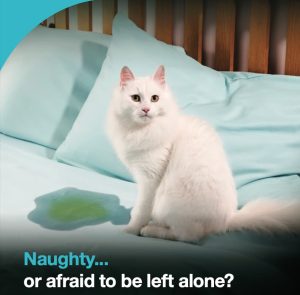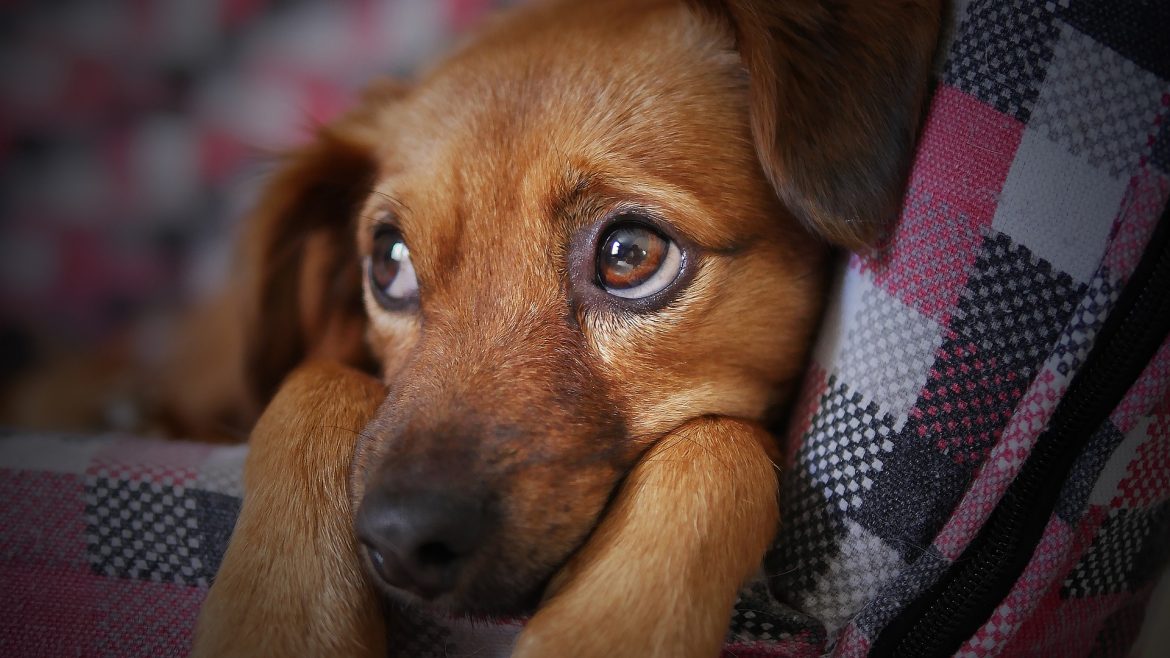Picture this: the weather has taken a turn for the worse and a storm has come over the city. Loud banging, wild winds, and heavy rain are battering your home.
For us, understanding the sudden change in conditions is easy. For our pets, however, these unexpected conditions can be frightening!
Another example: it’s new years eve and the fireworks are starting. For humans, it’s a time for celebration and ringing in a new year of possibilities. For dogs and cats, the loud blasts and coloured skies cause havoc on their nervous system.
Dogs and cats are creatures of habit. So when something in their orbit changes suddenly, they’re sent into a fit of stress and anxiety. Sometimes it can even lead to them escaping, as a way to flee from the danger. This can cause even more stress on both of you if your pet then goes missing!


As a pet owner, understanding the signs of stress in dogs and cats can help you intervene early and provide the comfort they need.
Here, we’ll explore common indicators of stress in pets and offer tips to manage their anxiety effectively.
Common signs of stress in dogs
Dogs express stress in various ways, often through changes in their behaviour or physical signs. Here are some of the most common indicators:
- Excessive barking or whining: Vocalising more than usual can signal anxiety or discomfort.
- Destructive behaviour: Chewing furniture, digging, or other destructive tendencies may occur, especially when left alone.
- Pacing or restlessness: Dogs who can’t seem to settle might be trying to cope with stress.
- Appetite changes: Stress can either suppress or increase a dog’s appetite.
- Excessive licking or chewing: This can sometimes escalate to skin irritation or bald patches.
- Trembling or panting: Physical symptoms like shaking or heavy breathing can indicate anxiety.
Signs of stress in cats
Cats are naturally more reserved than dogs, but they exhibit stress through subtle cues:
- Hiding: A stressed cat might retreat to secluded spaces more often.
- Changes in grooming habits: Over-grooming or neglecting grooming entirely can indicate anxiety.
- Aggression or withdrawal: Cats might lash out or become uncharacteristically distant.
- Litter box issues: Stress can lead to accidents outside the litter box.
- Vocal changes: Excessive meowing, growling, or hissing could signify distress.
- Pacing or tail flicking: Repetitive movements or a flicking tail often signal agitation.
Common causes of stress and anxiety in dogs & cats
Stress and anxiety in pets can be triggered by a number of situations, but are more commonly responsible for causing discomfort:
- Trips to the vet
Visits to the vet, while necessary, can be a major stressor for pets. The unfamiliar smells, sounds, and handling by strangers can leave pets feeling uneasy. For some, the experience may also be associated with previous vaccinations or treatments, heightening their anxiety. - Encounters with other (unknown) animals
Meeting unfamiliar animals, whether at the park, during a walk, or even through a window, can be intimidating for pets. Dogs may react with barking or pulling on the leash, while cats may retreat or hiss in defence. - Travelling in the car
For many pets, car rides can be overwhelming. The motion, confined space, and unfamiliar environment may lead to anxiety. Additionally, if car rides are only associated with vet visits or boarding, pets may anticipate stress even before the journey begins. Consider a dog car bed to help promote calm and provide a safe space while on the road. - Visiting a new environment
Moving to a new home, staying at a friend’s house, or even going to a pet-friendly café can be daunting for pets. The change in surroundings, new smells, and unfamiliar faces can make them feel insecure. - Sudden, loud noises
Events like fireworks and even household noises like the vacuum can startle pets. Even new noises like bringing home a baby can change the dynamic and cause a degree of upset. - Changes in weather
Weather shifts, especially storms, heavy rain and thunder claps can unsettle pets. Their heightened senses make them particularly sensitive to unexpected sounds, often causing them to hide, shake, or vocalise their discomfort. - Leaving them alone (Separation anxiety)
Separation anxiety is one of the most common forms of stress in both dogs and cats. Pets with separation anxiety may exhibit symptoms like excessive howling, destructive behaviour, or accidents when left alone. In cats, it may manifest as over-grooming or clingy behaviour.
By recognising these common triggers, Pet Owners can take proactive steps to comfort their pets during challenging times. Understanding their perspective is the first step in creating a stress-free environment for your furry friends.


How to help manage stress or anxiety in your furry friend
If your pet is showing signs of stress or anxiety, there are steps you can take to help them feel more secure and relaxed.
- Create a safe space
Provide a quiet area where your pet can retreat to when feeling overwhelmed. This could be a cosy corner with their favourite bed, toys, or blankets. - Establish a routine
Pets thrive on consistency. Feeding, regular dog walks, and playtime should occur at the same times each day to reduce unpredictability. - Offer mental and physical stimulation
Regular play, interactive toys, and puzzle feeders can help keep your pet’s mind engaged and alleviate boredom-related stress. - Use positive reinforcement
Reward calm and relaxed behaviour with treats, praise, or affection to reinforce a sense of security. - Consult your vet
If stress or anxiety persists, consult a vet for guidance. They may suggest behavioural training or supplements to help manage anxiety.
A trusted and proven solution for managing the signs of stress in dogs and cats is Zylkene®.
Recommended by many vets around the world, Zylkene® is a gentle yet effective supplement made from natural ingredients. In fact, it’s the only veterinary supplement formulated with alpha-cazosepine – a natural ingredient derived from bovine hydrolyzed milk protein – that has clinically proven calming properties.
 Can Zylkene® be used as a longer term solution for pets in challenging situations?
Can Zylkene® be used as a longer term solution for pets in challenging situations?
Yes – because it’s made with natural ingredients, your pet can stay calm and relax using Zylkene® for as long as required.
Is Zylkene® safe to use on puppies and kittens?
Yes, it’s safe to give to puppies and kittens and even safe for pregnant and nursing mothers.
Will Zylkene® make my pet drowsy?
No, the formulation is non-sedating so it helps your pet to stay calm without affecting their personality.
Can I give my pet Zylkene® if they’re on other medications?
Yes, Zylkene® is safe to give to dogs and cats that take other medications without causing any disruption.
How do I administer Zylkene®?
Zylkene® is a powder supplement and can be given in capsule format or opened and sprinkled onto their meal. It’s also water-soluble, odourless and tasteless – so even the most discerning pet won’t know it’s mixed into their food or water! Zylkene® is also available in palatable, chewable format for dogs!
Zylkene® helps relax and calm your pets so you can enjoy your bond with your furry friends!
Addressing your pet’s challenging situation requires understanding, patience, and proactive measures. By recognising the signs and taking steps to anticipate the triggers can help improve their overall wellbeing.
For pet owners seeking a convenient and effective way to support their furry friends, Zylkene® provides a reliable solution. Always consult your veterinarian to determine the best approach for managing your pet’s behavioural challenges.
Your pet deserves to live a happy, relaxed life—and with the right care and tools, they can!
Zylkene® is a registered trademark of Vetoquinol.

